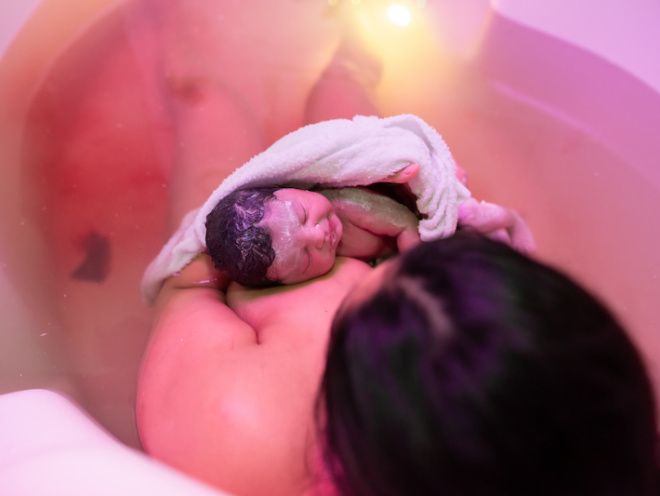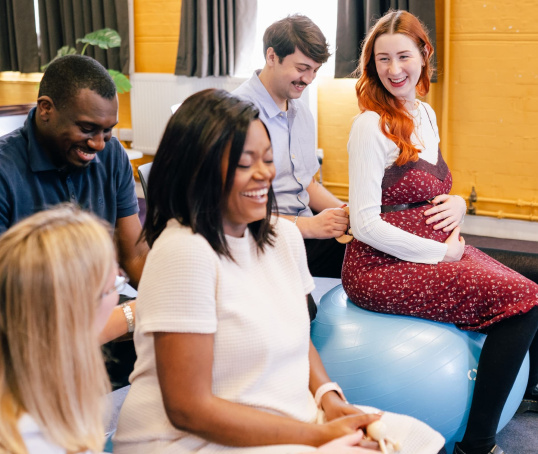Giving birth or at least labouring in water is becoming ever more popular and for good reason. It’s a great pain reliever and more. Here we explain all.
Whether or not you’re much of a water baby yourself, labouring or giving birth in water has a whole load of advantages. The great thing is that you should be offered the chance to labour in water, if possible, whether you’ve had children before or are a first-time mother (NICE, 2014).
About 10% of women in the UK give birth in pools but nearly 20% use water for pain relief (CQC, 2018). Water births started gaining in popularity when the Department of Health recommended them for pain relief in 1993 (Winterton, 1992; Cumberledge et al, 1993; Garland, 2000). But it’s not just about the pain…
Why use water in labour or for giving birth?
- Women say they feel more relaxed, involved in decision-making and more in control when using water for labour and birth.
- It is an effective pain reliever – women use less epidural or spinal pain relief when they have access to water.
- It’s safe for you and your baby – there is no increased chance of the baby being admitted to neonatal care after a water birth.
- It might make the first stage of labour shorter and one study said it shortened labour by almost two hours.
- Less or equal blood loss.
(Cluett et al, 2018; Dekker, 2018; RCM, 2018; Ulfsdottir et al, 2018)
Can water births prevent tearing, episiotomy or interventions?
It won’t prevent tearing or episiotomy but it’s possible water births might make them less likely. Yet the evidence is mixed and there has been no research in midwifery-led settings, where there are fewer interventions in any case than in hospitals (Brocklehurst et al, 2011; Cluett et al, 2018).
One study suggests there is less chance of interventions or second-degree tears with water births (Ulfsdottir et al, 2018). While a large review of various studies suggests water has little effect on tearing or interventions in the first stage of labour. That review couldn’t make any conclusions on the rates of tearing for the second stage of labour as the studies did not record them (Cluett et al, 2018).
Another review suggested there is a higher chance of straightforward birth in an upright position with midwife’s ‘hands off’ the perineum with a water birth. They also said that labouring or giving birth in water might make bad tears and episiotomies less likely but may mean minor tears are more likely (Dekker, 2018).
Are water births safe for the baby?
Yes, water births are safe. It makes no difference in how healthy babies are, and they’re no more likely to have difficulty breathing or to die. In fact, some research suggests your baby is less likely to need a transfer to hospital or stay in hospital or to be admitted to neonatal intensive care. Your baby won’t get cold either – there’s no increase in newborn hypothermia with water births (Dekker, 2018).
As for infections, they’re not more likely to get group B Strep infections. Water births also make no difference to babies’ microbiomes (Dekker, 2018).
What are the potential risks of a water birth?
Training has become standardised so that situations like babies inhaling water have not been seen for many years. Even when that has happened in the past, the babies recovered. Midwives are trained to be gentle with the cord too when guiding the baby out of the water, to prevent a (rare) cord snap (Dekker, 2018).
There is no increase in the risk of infection in newborns but some isolated cases have been reported. Effective cleaning and pool management protocols have reduced the chance of this happening.
As for the mums, water births carry no increased risk of maternal infections (Dekker, 2018).
Can you have water births with gas and air, TENS, epidurals or pethidine?
It's not possible to have an epidural in water. TENS is electrical stimulation so it’s also incompatible with water births.
As for what you can use in water, you can breathe a bit sigh of relief that entonox (gas and air) is fine for water births. And you can use self-help techniques like breathing, movement, massage, visualisation, distraction, or other complementary therapies to your heart’s content in water.
When it comes to epidurals, a few women labour in water for a while but get out to have an epidural or further assistance. In any case, labouring in water seems to reduce the chance of having an epidural (Cluett et al, 2018). Water also reduces the need for other forms of pain relief, and women are more satisfied with the pain relief water provides (Dekker, 2018).
A woman can use both water and opioids (e.g. pethidine) during labour, but not at the same time. If she has used pethidine she will need to wait for guidance from her midwife that it has passed out of her system before getting in the water, usually a few hours.
When can’t I labour or birth in water?
The NICE guidelines say that all ‘healthy women and babies...between 37 and 42 weeks of gestation’ should be offered the opportunity to labour in water (NICE, 2014). But here’s where it gets complicated – women outside of those criteria are not actually excluded from using water in labour. What it actually means is that this is an opportunity for you and your health professionals to explore each other’s concerns, before you decide.
There might be local guidance too and you can ask for this. You can also ask to talk with a consultant midwife to explore your options. All NHS midwives are trained to support women birthing in water.
The local Maternity Voices Partnership (MVP), or AIMS may also be interested in supporting you if you want, and these contacts can be found on the internet.
When an NHS Trust is not comfortable with supporting a woman in hospital, some women will decide to use a pool at home, with either an NHS or an independent midwife.
Can I have a water birth if I have a high BMI?
Your BMI (body mass index) will be taken into consideration along with your preferences, mobility, and any other conditions (NICE, 2019). You can talk to your health professional about how your BMI might affect things (NICE, 2019). Local guidance may affect whether women with high BMIs have water births (Marshall, 2019).
Can I have a water birth if I have herpes?
If you’re in the third trimester of your pregnancy and it’s the first time you’ve had genital herpes, you’ll be offered a planned caesarean. This is because a caesarean decreases the risk of passing the infection to the baby (NICE, 2011).
If you have a recurrence of herpes, you won’t be routinely offered a caesarean because of the lack of evidence that a caesarean will reduce the risk of passing on the infection to the (NICE, 2011). It’s best to talk with the health professionals caring for you about how a recurrence of herpes may affect your choice for a water birth.
Can I have a water birth if I’m expecting twins?
Selective (caesarean) birth may be offered early to reduce risk for the babies, while expectant management (watchful waiting) is also possible (NICE, 2011a). Women can discuss options with their carers, and some women will decide to birth in a pool.
Can I have a water birth if I have Group B Strep?
Guidelines say there is no reason you can’t use water during labour and birth as long as you’re offered intrapartum antibiotic prophylaxis (IAP) (RCOG, 2017). Although one report suggested there was insufficient evidence around transmission of Group B Strep, with no increased chance found in the available evidence (Dekker, 2018).
Can I have a water birth if I have gestational diabetes?
The concern here is likely to be the estimated size of the baby and its effect on the progress of labour, i.e. you may be offered an induction. You can discuss this with the health professionals who are caring for you. Some women choose to have a water birth with well-controlled gestational diabetes.
Can I have a water birth if I am due to be induced?
This tends to fall under local practice. Where appropriate facilities exist (i.e. a pool on the obstetric unit) and staff are confident, then women do have water births even when the labour is being induced.
This page was last reviewed in March 2019
Further information
Our support line offers practical and emotional support with feeding your baby and general enquiries for parents, members and volunteers: 0300 330 0700.
We also offer antenatal courses which are a great way to find out more about labour and life with a new baby. There might also be an NCT Waterbirth workshop in your area.
A Guide to Water Birth, 12-minute video.
Brocklehurst P, Hardy P, Hollowell J, Linsell L, Macfarlane A, McCourt C, Marlow N, Miller A, Newburn M, Petrou S, Puddicombe D, Redshaw M, Rowe R, Sandall J, Silverton L, Stewart M. (2011) Perinatal and maternal outcomes by planned place of birth for healthy women with low risk pregnancies: the Birthplace in England national prospective cohort study. BMJ.343:d7400. Available from: https://www.ncbi.nlm.nih.gov/pubmed/22117057 [Accessed: 13th November 2018]
Cluett ER, Burns E, Cuthbert A. (2018) Immersion in water in labour and birth. Cochrane Database Syst Rev. (5):CD000111. Available from: https://www.cochrane.org/CD000111/PREG_immersion-water-labour-and-birth [Accessed 13th November 2018]
CQC. (2018) 2017 Maternity survey: national tables for England. Available from: https://www.cqc.org.uk/publications/surveys/maternity-services-survey-2017 [Accessed 13th November 2018]
Cumberledge J; Expert Maternity Group; Department of Health. (1993) Changing childbirth. Part 1, report of the expert maternity group, London, HMSO. [Accessed 13th November 2018]
Dekker R. (2018) The evidence on: waterbirth. Available from: http://evidencebasedbirth.com/waterbirth/ [Accessed 4th March 2019]
Garland D. (2000) Waterbirth: an Attitude to Care. 2nd edition. Oxford: Books for Midwives Press
Marshall A. (2019) High BMI waterbirth – time for trusts to take the plunge? AIMS Journal. 31(2). Available from: https://www.aims.org.uk/journal/item/waterbirth-high-bmi [Accessed 13th November 2018]
NICE. (2014) CG190 Intrapartum care. Available from: https://www.nice.org.uk/guidance/cg190/chapter/recommendations#timing-of-regional-analgesia [Accessed 13th November 2018]
Public Health England. (2014) Patient safety alert: Legionella and heated birthing pools filled in advance of labour in home settings. Available from: https://www.england.nhs.uk/wp-content/uploads/2014/06/psa-legionella-birth-pool.pdf [Accessed 4th March 2019]
RCM. (2018) RCM Midwifery blue top guidance No. 1, London, Royal College of Midwives.
Ulfsdottir H, Saltvedt S, Georgsson S (2018) Waterbirth in Sweden – a comparative study. Acta Obstet Gynecol Scand. 97(3):341-348. Available from: https://www.ncbi.nlm.nih.gov/pubmed/29288489 [Accessed 13th November 2018]
Winterton N. (1992) Maternity Services: Second report of the House of Commons Health Committee (The Winterton Report), London, HMSO.
Further reading
Lewis L, Hauck YL, Crichton C, Barnes C, Poletti C, Overing H, Keyes L, Thomson B. (2018) The perceptions and experiences of women who achieved and did not achieve a waterbirth. BMC Pregnancy and Childbirth. 18(1):23. Available from: https://www.ncbi.nlm.nih.gov/pmc/articles/PMC5763519/ [Accessed 13th November 2018]
Redshaw M, Henderson J. (2015) Safely delivered: a national survey of women’s experience of maternity care 2014, Oxford, NPEU.





